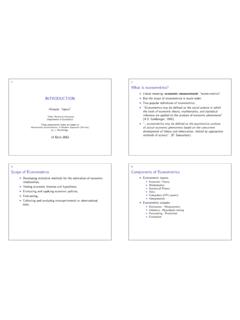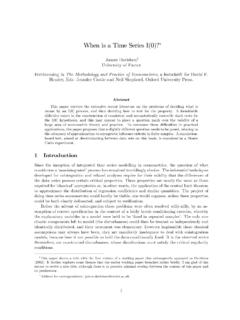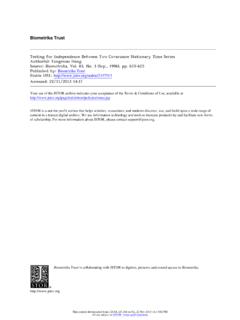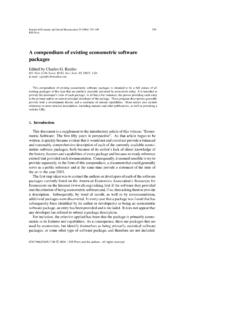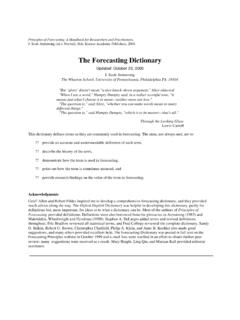Transcription of Environmental Kuznets Curve - David Stern
1 Environmental Kuznets CurveDAVID I. STERNR ensselaer Polytechnic InstituteTroy, New York, United States1. Introduction2. Theoretical Background3. Econometric Framework4. Results of EKC Studies5. Theoretical Critique of the EKC6. Econometric Critique of the EKC7. Other Evidence8. Decomposing Emissions9. ConclusionsGlossarycointegrationClassica l regression analysis assumes thatthe error term in a regression is normally andindependently distributed. An extreme violation of thiscondition is when the error term is a random walk. Sucha regression is termed a spurious regression and theresults are not reliable.
2 It usually indicates that arequired variable with random walk behavior has beenomitted from the model or that the variables in themodel follow random walks and are not related to estimationMay show bias and inefficiency,but both are reduced toward zero as the sample economiesCountries with high income levels;typically have an income per capita greater than $10,000, life expectancy greater than 70 years, andliteracy rates greater than 95%.developing economiesCountries with low- and middle-income levels; equivalent to the term Third World. econometricsThe specialized branch of mathematicalstatistics applied to the analysis of economic growthAn increase in economy-wide economicproduction usually measured by an increase in grossdomestic product; also, the process of the economygrowing over degradationAny human-caused deteriora-tion in Environmental a production or consumption activityhas unintended damaging effects, such as pollution, onother firms or individuals and no compensation is paidby the producer or consumer to the affected parties(negative externality).
3 When activities have beneficialeffects for others, such as freely available researchresults, and the recipients do not pay the generator ofthe effect (positive externality).heteroskedasticityWhen the variance of the error term in aregression model varies systematically across observa-tions or elasticityThe percentage increase in some variablewhen income increases by 1%.income per capitaUsually computed as the gross nationalproduct of a country for one year divided by the variableA random walk is an integratedvariable the current value is equal to the previousperiod s value plus a random shock.
4 This means that theeffect of these shocks on the future does not decline overtime. Rather, the current value of the variable is anintegration of all past variables biasOccurs when variables that shouldbe in a regression model are omitted and they arecorrelated with those variables that are dataA data set that includes observations of anumber of individuals, countries, firms, and the likeover a number of time periods such as months or biasWhen there is mutual feedback betweentwo variables and ordinary regression analysis cannotprovide consistent estimates of model developmentIf the current average well-beingof people could be maintained into the indefinite changeThe invention and introduction ofnew methods of production as well as new Environmental Kuznets Curve is a hypothesizedrelationship among various indicators of environ-mental degradation and income per capita.
5 Duringthe early stages of economic growth, degradationand pollution increase, but beyond some level ofincome per capita (which will vary for differentindicators) the trend reverses, so that at high incomelevels economic growth leads to environmentalimprovement. This implies that the environmentalEncyclopedia of Energy, Volume Elsevier Inc. All rights indicator is an inverted U-shaped function ofincome per capita. Typically, the logarithm of theindicator is modeled as a quadratic function of thelogarithm of INTRODUCTIONAn example of an estimated Environmental Kuznetscurve (EKC) is shown in Fig.
6 1. The EKC is named forSimon Kuznets , who hypothesized that income in-equality first rises and then falls as economic develop-ment proceeds. Emissions of various pollutants,such as carbon dioxide, sulfur, and nitrogen oxides,are tightly coupled to the use of energy. Hence, theEKC is a model of the relationship among energy use,economic growth, and the EKC is an essentially empirical phenomenon,but most of the EKC literature is statistically weak. Itis very easy to do bad econometrics, and the historyof the EKC exemplifies what can go wrong. The EKCidea rose to prominence because few paid sufficientattention to the relevant diagnostic statistics.
7 Little orno attention has been paid to the statistical proper-ties of the data used such as serial dependence andrandom walk trends in time series, and few tests ofmodel adequacy have been carried out or , one of the main purposes of doingeconometrics is to test which apparent relationshipsare valid and which are spurious we do take such statistics into account anduse appropriate techniques, we find that the EKC doesnot exist. Instead, we get a more realistic view of theeffect of economic growth and technological changeson Environmental quality. It seems that most indica-tors of Environmental degradation are monotonicallyrising in income, although the income elasticity isless than and is not a simple function of incomealone.
8 Time-related effects, intended to model tech-nological change common to all countries, reduceenvironmental impacts in countries at all levels ofincome. However, in rapidly growing middle-incomecountries, the scale effect, which increases pollutionand other degradation, overwhelms the time effect. Inwealthy countries, growth is slower and pollutionreduction efforts can overcome the scale effect. This isthe origin of the apparent EKC econometric results are supported by recentevidence that, in fact, pollution problems are beingaddressed and remedied in developing article follows the development of the EKCconcept in approximately chronological order.
9 Sec-tions II and III review in more detail the theorybehind the EKC and the econometric methods usedin EKC studies. Sections IV to VI review some EKCanalyses and their critiques. Section VII discusses therecent evidence from Dasgupta and colleagues andothers that has changed the way in which we viewthe EKC. The final two sections discuss an alternativeapproach, decomposition of emissions, and summar-ize the THEORETICAL BACKGROUNDThe EKC concept emerged during the early 1990swith Grossman and Krueger s pathbreaking study ofthe potential impacts of the North American FreeTrade Agreement (NAFTA)
10 And Shafik and Bandyo-padhyay s background study for theWorld Develop-ment Report , the idea that economicgrowth is necessary for Environmental quality to bemaintained or improved is an essential part of thesustainable development argument promulgated bythe World Commission on Environment and Devel-opment inOur Common EKC theme was popularized by the Interna-tional Bank for Reconstruction and Development s(IBRD)World Development Report 1992,whichargued that the view that greater economic activityinevitably hurts the environment is based on staticassumptions about technology, tastes, and environ-mental investments and that as incomes rise, thedemand for improvements in Environmental qualitywill increase, as will the resources available forinvestment.

